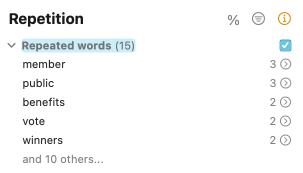Accessing the Guides
From other software
To access guide articles, launch Antidote and select the desired guide. How you launch Antidote depends on the software you are using.
- To learn how to launch Antidote from within your favourite software, click the Help menu in Antidote’s menu bar and select Integration of Antidote With Your Software (Connectix)
Context-sensitive access from the corrector


Access to the guides from the corrector is context-sensitive, meaning that Antidote opens the specific article that applies to the current detection. To consult the guide article associated with a given detection, select the detection and do one of the following:
- Click the guides icon () in the upper right-hand corner of the tool bar.
- Click the detection to display the tooltip, then press the + key or click the orange title that precedes the explanation.
- Open the context menu (right click) and select the guides icon ().
A green detection title links to a word’s definition or conjugations. A grey title indicates that the dictionaries and guides contain no information on the current detection.
Context-sensitive access from the style and revision filters

Each filter in the style view and revision prism is associated with an article in the language guides to help you evaluate any changes you may need to make to your text. To read the article associated with a given filter, hover your mouse over its title in the list of detections and click the icon that appears. You can also click the icon in the top right-hand corner of the list of detections to read an article that provides a general portrait of the current view or prism.
Context-sensitive access from the dictionaries
Dictionary of definitions

The Details panel in the dictionary of definitions often includes orange hyperlinks. Click one of these links to open an article in the guides that relates to the headword. Clicking a blue usage label (e.g. INFORMAL) in the body of the definition opens an article relating to that label.
Dictionary of conjugations
Clicking the green heading for a verb mood or tense will open the corresponding article in the guides that explains the use of that mood or tense.
Historical dictionary
The etymology section of the historical dictionary displays the source language(s) of the headword in orange. Click one of these orange hyperlinks to open an article in the guides about the corresponding language and its contribution to English.